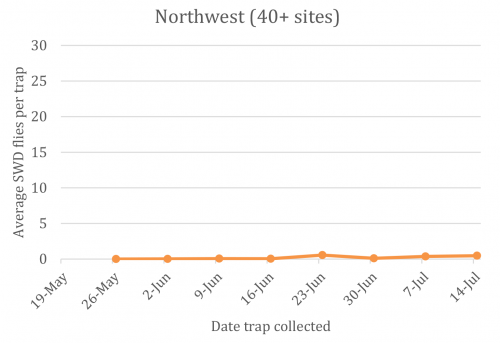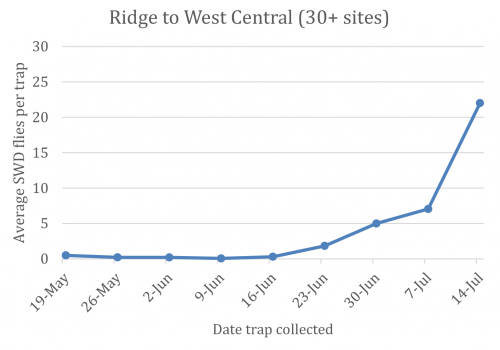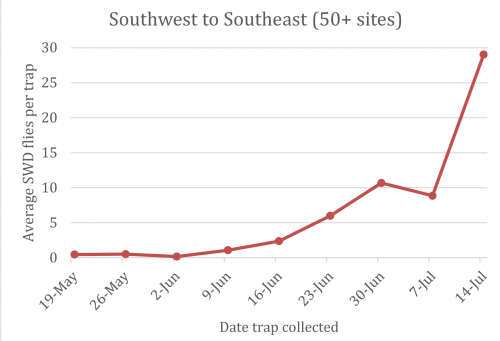Michigan spotted wing Drosophila report for July 18, 2017
Trap catches are sharply up in southwest, southeast, Fruit Ridge and west central Michigan. Ripe and ripening fruit in susceptible crops should be protected.

Michigan State University Extension fruit team members continue to monitor for spotted wing Drosophila (SWD) across the fruit producing regions of Michigan with more than 140 traps set up in susceptible crops or non-crop hosts.
The number of SWD flies caught in traps over the past week across southern Michigan, including the Fruit Ridge and west central regions, are sharply up in traps checked by MSU staff and private consultants. This is an unusually early increase in SWD activity. As mentioned last week, some traps are catching mostly female SWD, so be aware that scouts looking only for males will be missing some important information. See our Spotted Wing Drosophila Identification Guide.
We are also starting to find more SWD larvae in salt tests of some fruit this week, especially in wild honeysuckle and from fruit at some abandoned sites. Most of these SWD larvae are the tiny first instars, but some have more mature (larger) larvae. Commercial farms using an effective spray program for this pest generally have it under control, with either zero or very low infestation.
Locations with a lot of woods nearby and especially those with honeysuckle and other wild plants ripening in the nearby woods are providing very high SWD pressure this season, so management programs should be enhanced in these locations.
During the week ending in July 14, 66 percent of all the traps reporting caught 2,162 SWD flies, of which 1,356 were female and 806 were male—that is three times as many as the week before. The graphs below show average numbers of SWD flies caught in traps each week starting the week ending in May 19.
Traps that have been catching SWD flies this season are placed in blueberry (Allegan, Ionia, Montcalm, Ottawa, Van Buren), sweet cherry (Kent, Lenawee, Macomb), tart cherry (Allegan, Antrim, Benzie, Berrien, Grand Traverse, Leelanau, Manistee, Mason, Monroe, Oceana, Van Buren), grape (Allegan, Berrien, Ingham, Ionia, Van Buren), peach (Allegan, Berrien), plum (Van Buren), raspberry (Allegan, Ingham, Kent) and strawberry (Ionia, Livingston, Macomb, Ottawa) blocks. Ripening fruit of susceptible crops in these counties are at risk of infestation by this pest.
Counties included in the 2017 trapping network are Allegan, Antrim, Benzie, Berrien, Grand Traverse, Ingham, Ionia, Kent, Leelanau, Lenawee, Livingston, Macomb, Manistee, Mason, Monroe, Montcalm, Muskegon, Oceana, Ottawa and Van Buren. All traps in the network are baited with commercially available lures and placed in susceptible crop fields or orchards, or in a location adjacent to susceptible crops. The majority of the traps this season are standard deli cup style traps baited with the commercial Scentry brand lure. Most of the traps are placed in areas where SWD infestation has been recorded in the past.
For more information on this pest, including how to identify, monitor and manage this pest in fruit crops, please visit the MSU Spotted Wing Drosophila webpage.
SWD regional graphs
These graphs show the average number of SWD flies caught in traps baited with lures for the past eight to nine weeks. Our efforts reveal that the surge in the average number of SWD flies caught in traps has occurred three to four weeks earlier than last year, which means populations that are big enough to cause serious damage are occurring earlier than ever before, with the usual lag expected between southwest and northwest regions. Traps in the northwest region are still catching very few to no SWD flies unless they are located right next to a wild host.

Northwest Michigan (40+ sites).

Ridge to west central Michigan (30+ sites).

Southwest to southeast Michigan (50+ sites).



 Print
Print Email
Email


